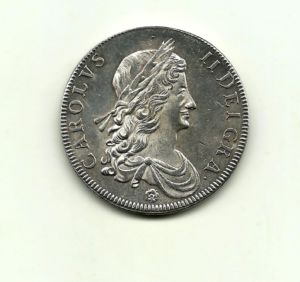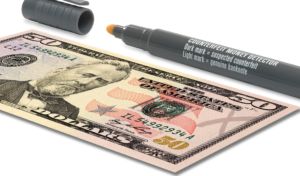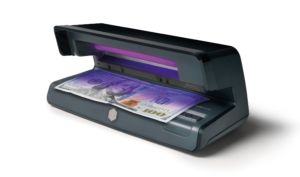Introduction
Counterfeit currency has plagued the United States economy since before the time of our founding fathers. This article will give a brief history on the origins of fraudulent money in the United States and the technology developed to make identification easier and duplication more difficult. These technologies include: UV detection, magnetic counterfeit detection, and watermark counterfeit detection.
Early Examples of Counterfeit Currency
Even before the use of paper money, counterfeiters would alter different forms of currency to gain an unfair advantage while trading goods. Dating back to the origins of the American colonies, native Americans would use shells known as wampum as a form of currency. Due to their rarity, blue-black shells had more value than white ones. As a result, some merchants would dye white shells a blue-black color and pass them off as higher-valued shells.
Shells were eventually replaced with gold or silver coins. A common practice was to clip or shave small amounts of silver or gold from these coins. Eventually, a clipper would accumulate enough shavings to sell them as bullion. Coin clipping prompted many monetary crises throughout Europe and its colonies. In fact, by 1695 clippers had reduced a large portion of the handmade coins to about half of their original weight. To combat this illegal practice, England began using machines to give coins milled edges in 1662. These ridges made it much easier to identify a clipped coin. Despite these efforts, the older pieces remained in circulation until the end of the century.

Great Britain Charles II crown 1662 coin with milled edges. Courtesy of Etsy.
Combating Counterfeit Currency
The U.S. Department of the Treasury first issued paper U.S. currency in 1862 to compensate for the shortage of coins and to finance the Civil War. In July of 1865, the Secret Service was created in Washington D.C. to suppress counterfeit currency. At the time, a third of all the currency in the United States was counterfeit. The establishment of the Secret Service was a crucial step in combating fraudulent bills. Furthermore, in 1995, the United States Government announced a significant redesign of the nation’s currency in an attempt to make modern day counterfeiting more difficult. This new design included high quality printing, printed serial numbers, seals by the U.S. Federal Reserve and Treasury, and the use of a very specific type of paper with small red and blue fibers embedded throughout the bill.
The Counterfeit Detector Pen
In a lot of instances today, counterfeiters will refrain from using an expensive press or special inks to try to closely duplicate paper currency. Instead, they attempt to create a bill that looks close enough to authentic and thus would not raise any initial suspicion when used in an everyday purchase. These counterfeiters are not very meticulous so they usually copy onto wood-based paper.
Perhaps one of the simplest tools used for counterfeit detection, the pen contains an iodine solution that reacts with the starch in wood-based paper to create a black, marker-like, stain. When the solution is applied to the fiber-based paper used in authentic bills, no discoloration occurs. This tool is useful for identifying amateur counterfeit currency. However, when dealing with more sophisticated counterfeit bills, utilizing a more complex detector may be necessary.

Counterfeit Detection Pen. Contains an iodine-based ink that reacts with the starch in wood-based paper to create a black stain. Courtesy of SafeScan.
UV Counterfeit Currency Detection
UV counterfeit detection is the most commonly used method to expose fraudulent bills. A UV detector verifies the UV marks on authentic notes by exposing them to ultraviolet light. These UV indications are created using non-visible dyes in the note fabrication process. These indications are only visible under UV photons. If the UV printed images glow when subjected to the UV light, then the bank note is expected to be authentic.

Ultraviolet counterfeit detector. Exposed UV light to bank notes to reveal UV printed images. Courtesy of SafeScan.
Magnetic Counterfeit Currency Detection
Magnetic counterfeit bill detection involves the use of specialized magnetic inks. These inks have pigments containing magnetic material such as iron oxide. This material is similar to what is used in the coatings of audio and video tapes. The magnetic properties embedded in the bills can be read by ink testing devices and currency counters with magnetic detection capabilities to distinguish genuine bills from counterfeit ones.
The simplest devices are hand-held units and single-bill readers that require the user to rub or slide the bill across a sensor. Assuming the bill is authentic, the device emits a signal to indicate the presence of magnetic material within the bank note. This signal is usually audible. These detectors are easy to use and relatively accurate. However, since they can only read one bill at a time, magnetic detectors would be impractical for large amounts of currency.
Conclusion
Despite the many attempts by the United States government to stay one step ahead of counterfeiters, there has always been at least a few criminals that have succeeded in their trade. While it is unknown exactly how much counterfeit money is in circulation at any given time, there are estimates of up to $3 billion USD.
To this day, it is reported that Secret Service appropriates tens of millions in counterfeit dollars annually. For this reason, counterfeit currency detectors are still very relevant. Businesses are the second line of defense against the trade of fraudulent money. It is essential for them to protect themselves and their customers from the crafty counterfeiters of today.
